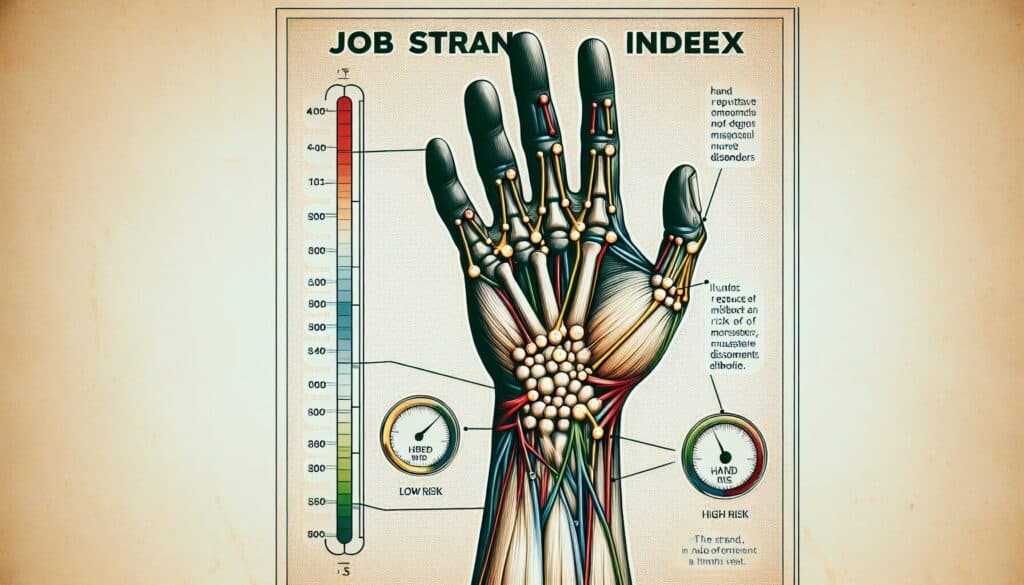Eine Methode zur Bewertung des Risikos von Muskel-Skelett-Erkrankungen der Hand, des Handgelenks, des Unterarms und des Ellbogens, die in erster Linie mit repetitiven, kraftvollen Belastungen einhergehen.
- Methodologien: Kunden & Marketing, Wirtschaft, Lean Sigma, Herstellung, Projektmanagement, Qualität
Arbeitsbelastungsindex (JSI)

Arbeitsbelastungsindex (JSI)
- Kontinuierliche Verbesserung, Ergonomie, Gesundheitswissenschaften, Menschliche Faktoren, Schlanke Fertigung, Prozessverbesserung, Qualitätsmanagement, Risikomanagement, Sicherheit
Zielsetzung:
Wie es verwendet wird:
- Berechnet eine Punktzahl auf der Grundlage der Belastungsintensität, der Belastungsdauer pro Zyklus, der Anstrengungen pro Minute, der Hand-/Handgelenkhaltung, der Arbeitsgeschwindigkeit und der Dauer der Aufgabe pro Tag. Ein Wert über einem Schwellenwert weist auf eine gefährliche Tätigkeit hin.
Vorteile
- Relativ einfach und schnell anwendbar, sobald die Daten erfasst sind; konzentriert sich auf die wichtigsten Risikofaktoren für Erkrankungen der distalen oberen Gliedmaßen; liefert einen einzigen Risikoscore.
Nachteile
- Berücksichtigt eine begrenzte Anzahl von Risikofaktoren; eignet sich möglicherweise nicht für alle Arten von Aufgaben der oberen Gliedmaßen; beruht bei einigen Faktoren auf subjektiver Einschätzung.
Kategorien:
- Ergonomie
Am besten geeignet für:
- Bewertung des Risikos der Entwicklung von Muskel-Skelett-Erkrankungen in den distalen oberen Extremitäten aufgrund von Arbeitsaufgaben.
The Job Strain Index (JSI) is particularly beneficial in various sectors that involve manual labor, such as manufacturing, construction, healthcare, and warehousing, where workers are susceptible to musculoskeletal disorders. This methodology is most effectively applied during the ergonomics assessment phase of workplace design or during the evaluation of existing job tasks to identify risks associated with specific work activities. It is typically initiated by occupational health and safety professionals, ergonomists, or human factors specialists, often in collaboration with workers, supervisors, and management to ensure a comprehensive understanding of job demands and work environments. The process includes observational studies and data collection on workers’ tasks, thereby engaging different stakeholders in the evaluation process, including engineers looking to improve Arbeitsplatz designs and occupational therapists assessing the impact of job requirements on individual health. The JSI score serves as a quantifiable measure that can drive interventions, such as redesigning tasks to minimize risk factors, implementing job rotation strategies, or offering training to modify manual handling techniques. Its user-friendly nature allows for quick on-site evaluations, making it a practical tool during safety audits or in the development of workplace initiatives that aim to enhance worker well-being while maintaining productivity standards. By providing a clear numerical risk assessment, JSI aids in prioritizing actions needed for improvement, offering a straightforward approach to risk management in operational settings.
Die wichtigsten Schritte dieser Methodik
- Determine the intensity of exertion for each task using a standardized scale.
- Evaluate the duration of exertion per cycle for each identified task.
- Count the number of efforts applied per minute for relevant tasks.
- Assess hand/wrist posture during each task using defined criteria.
- Measure the speed of work for each task as part of the analysis.
- Estimate the duration of the task performed each day.
- Calculate the Job Strain Index score by combining all the assessed parameters.
- Compare the calculated score against established threshold values to determine risk level.
Profi-Tipps
- Integrate task observations with JSI calculations to capture real-world variations in exertion levels and to inform design adjustments.
- Utilize the JSI data as a baseline for iterative design changes and re-evaluate periodically to track the effectiveness of ergonomic interventions.
- Collaborate with multidisciplinary teams to assess context-specific variables such as environment and workflow, enhancing the accuracy of the JSI application.
Verschiedene Methoden lesen und vergleichen, Wir empfehlen die
> Umfassendes Methoden-Repository <
zusammen mit den über 400 anderen Methoden.
Ihre Kommentare zu dieser Methodik oder zusätzliche Informationen sind willkommen auf der Kommentarbereich unten ↓ , sowie alle ingenieursbezogenen Ideen oder Links.
Historischer Kontext
1986
(wenn das Datum nicht bekannt oder nicht relevant ist, z. B. "Strömungsmechanik", wird eine gerundete Schätzung des bemerkenswerten Erscheinens angegeben)

Verwandte Artikel
Fragebögen zu muskuloskelettalen Beschwerden
Multivariate Tests (MVT)
Mehrfache Regressionsanalyse
Motion-Capture-Systeme
MoSCoW-Methode
Moods Median-Test